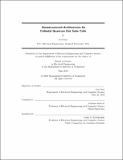| dc.contributor.advisor | Vladimir Bulović. | en_US |
| dc.contributor.author | Jean, Joel, Ph. D. Massachusetts Institute of Technology | en_US |
| dc.contributor.other | Massachusetts Institute of Technology. Department of Electrical Engineering and Computer Science. | en_US |
| dc.date.accessioned | 2013-11-18T17:37:36Z | |
| dc.date.available | 2013-11-18T17:37:36Z | |
| dc.date.copyright | 2013 | en_US |
| dc.date.issued | 2013 | en_US |
| dc.identifier.uri | http://hdl.handle.net/1721.1/82187 | |
| dc.description | Thesis (S.M.)--Massachusetts Institute of Technology, Dept. of Electrical Engineering and Computer Science, 2013. | en_US |
| dc.description | This electronic version was submitted by the student author. The certified thesis is available in the Institute Archives and Special Collections. | en_US |
| dc.description | Cataloged from student-submitted PDF version of thesis. | en_US |
| dc.description | Includes bibliographical references (p. 73-79). | en_US |
| dc.description.abstract | This thesis introduces a novel ordered bulk heterojunction architecture for colloidal quantum dot (QD) solar cells. Quantum dots are solution-processed nanocrystals whose tunable bandgap energies make them a promising active-layer candidate for next-generation optoelectronic devices, including solar cells and light-emitting diodes. Despite rapid advances in performance, however, modern QD solar cells remain limited by a fundamental trade-o between light absorption and photocarrier collection due to poor electronic transport. Vertically aligned arrays of ZnO nanowires can decouple absorption and collection: The nanowires penetrate into the QD film and serve as highly-conductive channels for extracting photogenerated electrons from deep within the film. After optimizing the nanowire growth and device fabrication processes, we nd that incorporating nanowires boosts the photocurrent and the eciency of planar QD photovoltaic devices by 50% and 35%, respectively. The demonstrated AM1.5G power conversion eciency of 4.9% is among the highest ever reported for a ZnO-based QD solar cell. We further show that graphene can serve as a viable alternative to tin-doped indium oxide (ITO) as a transparent conductive electrode for thin-film optoelectronics. We grow ZnO nanowires on graphene and fabricate prototype graphene-based ordered bulk heterojunction QD devices with photovoltaic performance approaching that of ITO-based solar cells. Our work shows that nanostructured architectures can substantially improve QD solar cell performance, and that a simple, low-temperature, bottom-up solution growth process can produce nanowire alignment and device performance matching that of top-down synthetic processes, with the added advantage of compatibility with a variety of rigid and flexible substrates. The 1-D nanostructure design principles we propose and apply here can be generalized to a broad range of optoelectronic device applications. This study of scalable bottom-up processing of ZnO nanowire-based QD solar cells suggests that 1-D nanostructures may be the key to enhancing the eciency and hence the economic viability of quantum dot photovoltaics. | en_US |
| dc.description.statementofresponsibility | by Joel Jean. | en_US |
| dc.format.extent | 79 p. | en_US |
| dc.language.iso | eng | en_US |
| dc.publisher | Massachusetts Institute of Technology | en_US |
| dc.rights | M.I.T. theses are protected by
copyright. They may be viewed from this source for any purpose, but
reproduction or distribution in any format is prohibited without written
permission. See provided URL for inquiries about permission. | en_US |
| dc.rights.uri | http://dspace.mit.edu/handle/1721.1/7582 | en_US |
| dc.subject | Electrical Engineering and Computer Science. | en_US |
| dc.title | Nanostructured architectures for colloidal quantum dot solar cells | en_US |
| dc.type | Thesis | en_US |
| dc.description.degree | S.M. | en_US |
| dc.contributor.department | Massachusetts Institute of Technology. Department of Electrical Engineering and Computer Science | |
| dc.identifier.oclc | 862111476 | en_US |
